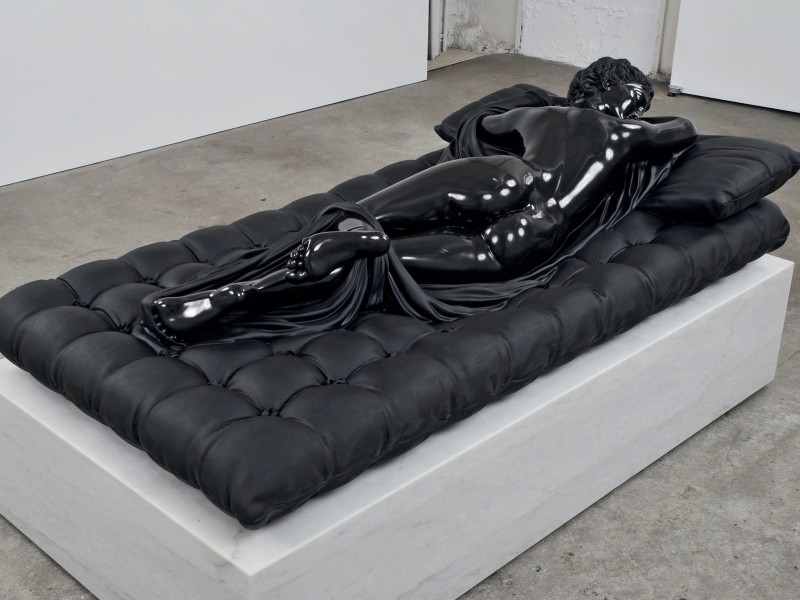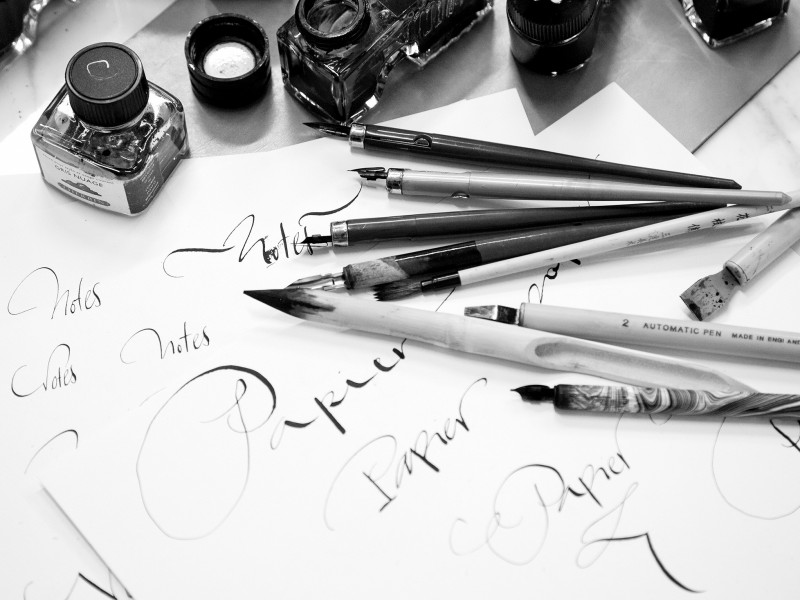Over the past year I’ve worked with Thierry-Maxime Loriot to bring The Fashion World of Jean Paul Gaultier: From the Sidewalk to the Catwalk to its Melbourne venue at the National Gallery of Victoria (NGV). We exchanged daily emails, telephone and skype calls, while working side by side through installation, along with Tanel Bedrossiantz, Thoaï Niradeth and Mireille Simon from Maison Jean Paul Gaultier; master hair stylist Odile Gilbert and her team of hairdressers including Tan Doan and Hugo Raiah and of course, special Australian member Stewart Graham. As well as the NGV crew of installers, builders, exhibition designers, registrars and conservators. The exhibition was adapted for its Melbourne home from its incarnations in London, Madrid, Montreal, Stockholm, New York, Dallas, San Francisco and Rotterdam. However it was the original conception of Thierry-Maxime Loriot; curatorial neue garde and self-confessed storyteller.
In 2009 he began to decipher the archive of Jean Paul Gaultier for the first presentation of the exhibition in Montreal in 2011, but he began to prepare for his role in research even earlier. Firstly encouraged by his parents on their frequent international travels, and then later his fashion industry experience as a model, he has combined his interests in architecture and contemporary art with an insatiable curiosity and interest in people. Much like Gaultier himself, Loriot shifted the landscape of fashion curatorial practice, presenting a complete universe of the designer with intelligent theatrics focusing on accessibility and storytelling.
Thierry-Maxime Loriot: I laughed when I read that Paola would conduct this interview. I thought to myself: She is an old friend, with her it’s going to be much more fun! How is the exhibition going in Melbourne?
Paula Di Trocchio: Really well. The interest is so strong. When Stuart Harrison from the radio show The Architects asked me when had we last done a show like this I replied, we have never done a show like this before. Our last single designer retrospective was Versace in 2000, but it did not have the theatrics of this exhibition, specifically with the animated mannequin faces, the moving runway, the mohawks... Did Gaultier allow you to present the show that you wanted to present?
TL: From day one he was quite open. I’m not into the classical fashion exhibitions, I’m not a purist. An exhibition should be about a person, a human being and their inspirations and collaborations. He collaborated with so many different people, from directors to performers to artists. I wanted to integrate these collaborations and show the exhibition more like his universe than something chronological. He had so many passionate obsessions throughout the years that were important to point out. He said, “just go into the archives, do your research, have fun, we’ll discuss later”. From then on every three weeks I would go to Paris and look through the archives. He made it easy for me to work with him. We were on the same page from the beginning.
PD: So how is the archive organised? How do you get into the archive and start to work it out?
TL: It is filled with racks upon racks upon racks. I’ll always remember the first time I went there, I felt like a kid. You start with 1000 objects and then you try them on mannequins, because weirdly they don’t always look good on a mannequin. So you have to edit down, edit down, edit down. In some venues it was supposed to be 110 costumes, but we have never been able to show less than 140. It’s unusual to have such a good archive. Most people, like Madonna, didn’t think to collect until later. Everything is very well kept. Now they know the importance of archiving. However it’s still not everything. At the book signing in Melbourne, a woman came up to us with a kilt made of lamé, which was from Gaultier’s Grease collection in 1978. He was so happy and so surprised, because he didn’t even have it in his archive. He was so proud to discover his first collections were admired in Australia.
PD: I noticed there are similarities between the names of some of the sections in the exhibition, like Punk Cancan, and Gaultier’s collection titles. Is that where you looked in order to name the themes of the sections?
TL: Yes and no. In both haute couture and ready-to-wear, designers don’t always name their collections, but Gaultier likes to do it the old-fashioned way. In all his couture collections, he has a name for every dress and it’s always something very fun. He takes couture very seriously. I was then inspired to find proper titles that would reflect his universe and the themes in his work. There is a section in the exhibition called Boudoir, but he has never done a boudoir inspired collection, but we had to reflect something that was related to his childhood and to corsetry and to find the proper word. It was fun to find it.
PD: I have been reading the book Exhibiting Fashion Before and After 1971, which reflects on Cecil Beaton’s curatorship at the Victoria & Albert Museum in 1971. I realised that there is an extraordinary historical difference between the exhibitions that were curated by previous scholars and the exhibitions that Beaton or Diana Vreeland curated. There was a dynamism and playfulness in the way that Beaton and Vreeland presented their exhibitions. Then I realised that both had worked inside the fashion industry before they curated those extraordinary shows. Vreeland was a former Vogue editor who later became special consultant at the Costume Institute of the Metropolitan Museum of Art. In the same vein, you have also worked inside the fashion industry when you were a model. Do you see your work in the fashion industry as something that has informed your work as a curator?
TL: Definitely. But I don’t think it’s just from my work inside the industry. Colin McDowell paid me the nicest compliment in his article in The Business of Fashion. He said that the two best exhibitions in fashion history are those that were curated by Vreeland and mine. That’s nice, coming from him, it’s quite flattering. Although I’m not saying I’m exactly like Vreeland. Of course working in the fashion industry has helped me develop relationships with photographers, designers, artists and collectors, but I consider myself a storyteller. I think different inspirations inspire you when you work. I think you can find inspiration from your childhood and past interests. I always wanted to be an architect, which is where the fun in exhibition design is. I love movies. I think we are both very lucky because we are very open-minded people. I think the same can be said about Tony Ellwood and Nathalie Bondil. They are both not afraid to take risks.
PD: When Philip Treacy came to Australia he said, “Models are the unsung heroes of the fashion industry”. The exhibition helps to draw out the creative role of the model. In the interview published in the accompanying publication, Australian model and muse Alexandra Agoston discusses her role in the creation of a dress.
TL: Yes, it’s not only about being beautiful. He’s really interested in collaboration and involving everyone in his work. But you have to be very confident about yourself and your work in order to be able to trust people and engage with them. That’s how I see people like Bondil and Ellwood. It’s the same thing. Bondil was in the movie industry before becoming a curator, so she travelled a lot and saw things. She was very open to other views. The way you are raised will also forge who you are going to become. My parents were diplomats when I was young and were travelling all the time. For example, we would plan to go to Italy one summer and they would tell my siblings and I to choose two cities each to research, and we would then have to conduct a tour for the whole family. They wanted us to understand the importance of research, and to be interested in other cultures and other people. I think my research comes from there. I’m more curious about others than about myself.
PD: Is there a storytelling element to modelling?
TL: It depends on which photographer you work with. If you work with the ones who have a very strong vision, like Peter Lindbergh, then yes. Lindbergh is really the one who invented editorial storytelling at the end of the 1980s. He is someone who was very influenced by movies and directors such as Fritz Lang and Win Wenders. He’s like an artist who directs his subjects to reflect his own vision, which is why it is important to have good models. For example Mario Testino has worked extensively with Kate Moss. She’s a bit like the Madonna of modelling. She is a chameleon who can transform from a goddess to a punk to a housewife. She can move to different directives. All these women have great careers and there is a clear reason for that.
PD: I also see the curator as a storyteller, and the exhibition as storytelling with objects. Continuing the analogy with film, do you agree that an exhibition should be a journey, and that each thematic section is like a different act in a film?
TL: Yes, that’s how I feel. It’s like a movie. An exhibition is entertainment. Really it is. You need to entertain people. You want your audience to appreciate your creative perspective, but sometimes it’s difficult to judge what people will respond to. It’s a very personal process. Similar to a movie or a book, an exhibition changes according to an audience’s interpretation. You know they are out there with their own point of view. It is also about giving access to the inaccessible.
PD: So after installing the exhibition in eight different venues, what was different about working at the National Gallery of Victoria?
TL: Honestly, everybody has said this was the very best venue. First the exhibition space is very nice and easy to work with. There are great perspectives from one gallery to the other. Secondly, exactly what I was saying about Ellwood is true of everyone, from you to Katherine Horseman and Ingrid Rhule, to Don Heron, to everyone. Everyone is just so nice and so easy to work with. It was a true collaboration in terms of finding solutions together. The NGV also had the whole community involved and with so many sponsors. Gaultier was very touched to see how much he was appreciated. People were crazy for him.
PD: So Paris is next, and then Munich. And then is that the last one?
TL: For now…!
Image Credits:
Image 01. Photo by Brooke Hold, courtesy of The National Gallery of Victoria.
Image 02. Photo by Brooke Hold, courtesy of The National Gallery of Victoria.
Image 03. Photo by Brooke Hold, courtesy of The National Gallery of Victoria.
Image 04. Jean Paul Gaultier, Apparitions dress, from Les Vierges (Virgins) collection haute couture Spring-Summer, 2007. Images copyright Patrice Stable/Jean Paul Gaultier.
Image 05. Jean Paul Gaultier, Tribute to Amy Winehouse, from collection haute couture Spring-Summer, 2012, dress with exaggerated hipline combining flower-motif silk embroidery, multicolored lacings and metal. Images copyright Patrice Stable/Jean Paul Gaultier.
Image 06. Photo by Brooke Hold, courtesy of The National Gallery of Victoria.
Footnotes:
1. See Colin McDowell, Colin’s Column, ‘Jean Paul Gaultier Fashion Incarnate’, The Business of Fashion, 7 April 2014.
Related Features
-
53
-
-
-

